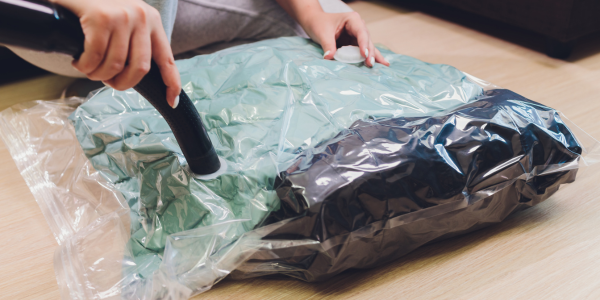
Easy & Eco-Friendly Clothing Care: Sustainable Tips
Sustainable Clothing Care: Easy & Eco-Friendly
The fashion industry is one of the largest contributors to environmental pollution, and it's time to acknowledge our responsibility towards it. Sustainable clothing care is an easy and eco-friendly way to reduce our carbon footprint and contribute towards a healthier environment. In this blog post, we'll dive deep into sustainable clothing care practices that are not only easy but also practical. We will discuss everything from understanding why sustainable clothing care is important to decoding care labels on your clothes, washing clothes less frequently, investing in quality clothing, using eco-friendly laundry detergents, and the art of hang drying clothes. We will also touch upon repairing clothes and how proper storage can contribute to sustainable clothing care. So, let's start making conscious choices for our planet by incorporating these simple changes in our daily lives.
Understanding Sustainable Clothing Care
Taking care of your clothes in a sustainable way is vital for reducing textile waste and minimizing the need for new purchases. By practicing sustainable clothing care, you can significantly reduce the environmental impact of the fashion industry. Incorporating sustainable clothing care habits into your routine promotes a more responsible wardrobe, while proper care techniques can help prevent shrinkage and color fading, ensuring your clothes last longer. Sustainable clothing care is a great way to extend the life of your garments and contribute to a more eco-friendly future.
Why is Sustainable Clothing Care Important?
Sustainable clothing care plays a crucial role in reducing the fashion industry's environmental impact. By adopting eco-friendly practices, such as proper care techniques and minimizing textile waste, you can support a more circular and responsible fashion system. Ultimately, sustainable clothing care helps preserve resources and contributes to a greener future.
Practical Steps for Sustainable Clothing Care
Investing in quality clothing is a great way to care for your clothes sustainably. By choosing well-made garments, you can ensure their durability and longevity, reducing the need for frequent replacements. Another practical step is decoding the care label on your clothes. This helps you understand the best practices for washing and drying, ensuring that you treat your garments with care. Additionally, washing your clothes less frequently is a sustainable approach. Not only does it conserve water and energy, but it also helps to extend the life of your clothing. When washing, consider using cold water to save energy and prevent color fading. Lastly, opt for eco-friendly laundry detergents that are free from harsh chemicals and safe for the environment.
Investing in Quality Clothing
Choosing garments made from sustainable materials like organic cotton, tencel, or linen is a great way to invest in quality clothing. Not only are these materials more eco-friendly, but they also tend to be more durable and resistant to wear and tear. By investing in high-quality clothing, you can reduce the need for frequent replacements and contribute to a more sustainable wardrobe. Opting for timeless pieces that can be styled in different ways ensures versatility and longevity. Additionally, buying from new brands that prioritize sustainability in their manufacturing process is a conscious choice that supports a more sustainable fashion industry. Investing in well-made undergarments also provides comfort and longevity, reducing the need for frequent replacements.

Decoding the Care Label on Your Clothes
Decoding the care label on your clothes is essential for maintaining their quality and longevity. The care label provides instructions on how to wash, dry, and iron your garments properly. By understanding the symbols on the care label, you can avoid damaging your clothes during cleaning. Following the care label instructions ensures that your clothes retain their shape and durability over time. It's important to pay attention to special instructions for delicate fabrics like silk or wool to avoid any potential damage. Deciphering the care label is a great way to ensure that your clothing remains in top condition without resorting to fast fashion or frequent replacements.
Washing Clothes Less Frequently: A Sustainable Approach
Adopting a sustainable approach to washing clothes involves reducing water and energy consumption. Instead of washing garments frequently, consider freshening them up through spot cleaning or airing them out. This "wear more, wash less" mentality not only extends the lifespan of your clothes but also reduces wear and tear. By laundering your clothes only when necessary, you save time, resources, and money in the long run. Another eco-friendly option is to air dry your clothes on a clothesline, which is gentle on fabrics. This sustainable approach to clothing care helps promote a more environmentally conscious lifestyle.
Why Should You Consider Washing Clothes in Cold Water?
Washing clothes in cold water is an eco-friendly choice that saves energy and reduces greenhouse gas emissions. It also helps preserve the color, shape, and lifespan of your garments. Switching to cold water washing can make a significant impact on your carbon footprint.
Eco-friendly Laundry Detergents: What to Look For?
When choosing eco-friendly laundry detergents, look for biodegradable options without harsh chemicals. Opt for environmentally friendly or specifically designed detergents for sustainable clothing care. Consider packaging made from recyclable materials or in refillable containers. Reduce packaging and transportation emissions by using detergent strips or powder. Look for certifications like the USDA Organic label to ensure environmental standards are met.
The Art of Hang Drying Clothes
Hang drying clothes is a great way to care for your clothing sustainably. Not only does it save energy and reduce utility bills by eliminating the use of a dryer, but it also has several other benefits. When you hang dry your clothes, the direct sunlight acts as a natural disinfectant and deodorizer. This is particularly useful for items like underwear or swimwear that require extra attention. Additionally, air drying helps preserve the shape and elasticity of garments, especially delicate fabrics like lingerie or swimwear. It also prevents shrinkage and extends the lifespan of your clothes, reducing the need for frequent replacements. Investing in a clothesline or drying rack can make hang drying clothes convenient and efficient, ensuring that your sustainable clothing care routine is both eco-friendly and effective.
Repairing Clothes: An Overlooked Aspect of Sustainable Clothing Care
Repairing clothes is an essential, yet often overlooked aspect of sustainable clothing care. By learning basic sewing skills, you can easily mend minor damages, ensuring that your clothes last longer and reducing the need for constant replacements. Patching up small holes or tears not only extends the lifespan of your garments but also gives them a new lease of life. Additionally, tailoring clothes to fit properly not only prolongs their usefulness but also reduces the urge to buy new items. Consider donating unwanted clothes to thrift stores or repurposing them into new creations, promoting a more conscious and sustainable approach to fashion.

How Does Proper Storage Contribute to Sustainable Clothing Care?
Proper storage plays a vital role in sustainable clothing care. Storing clothes in airtight containers prevents damage and extends their lifespan. Natural moth repellents like cedar or lavender protect clothes without harsh chemicals. Hanging delicate items on padded hangers prevents stretching or distortion. Neatly folding clothes reduces the need for ironing, saving energy and time. Keeping clothes in a cool, dry place prevents mold and mildew growth.
Can I Contribute to Sustainability by Donating or Selling Worn-out Clothes?
Donating or selling worn-out clothes is a great way to contribute to sustainability. It promotes reuse, reduces waste, and extends the lifespan of garments. By choosing to donate or sell clothes instead of throwing them away, you can help reduce landfill waste and support a circular economy. Repurposing or recycling donated/sold clothes into new materials further adds to their sustainability.
To truly embrace sustainable clothing care, it requires a shift in mindset and habits. By investing in quality clothing, decoding care labels, washing clothes less frequently, opting for cold water washes, and using eco-friendly laundry detergents, you can significantly reduce your environmental impact. Additionally, embracing the art of hang drying clothes and repairing worn-out garments extends their lifespan and further reduces waste. Proper storage techniques also play a role in sustainable clothing care, as they help maintain the quality and longevity of your clothes. And finally, consider donating or selling your worn-out clothes instead of throwing them away to contribute to a circular fashion economy. Together, these steps empower you to make a positive difference in the fashion industry and protect our planet.


